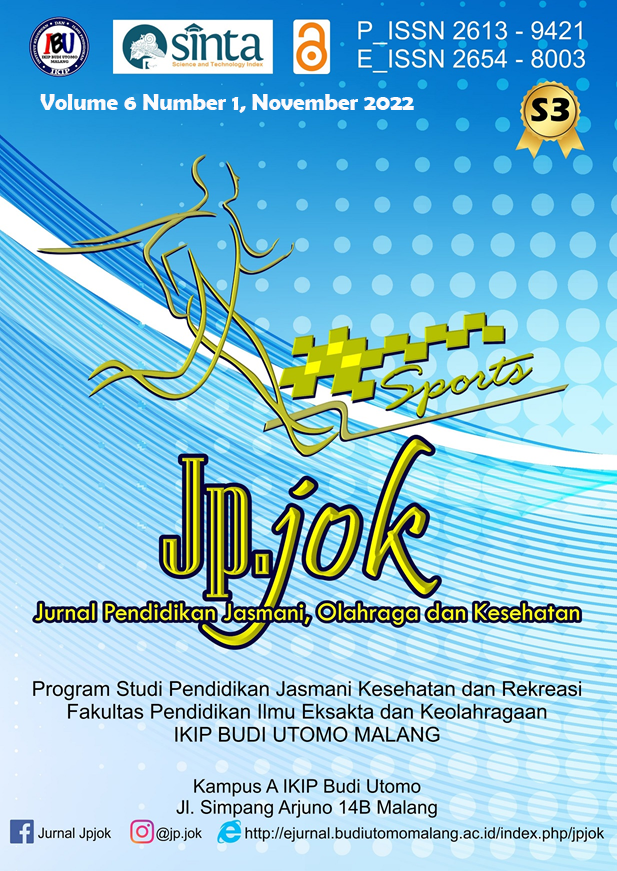Survey of Student Interest in Participating in Physical Education Learning at MAN 1 Malang
Abstract
The purpose of this study was to determine the interest of students in participating in the learning of Physical Education, Sports, and Health at MAN 1 Malang. The method used is a survey, the data collection technique uses a questionnaire, and the scores obtained from the questionnaire are then analyzed using descriptive and quantitative analysis as outlined in the form of percentages. The sample used in this study were students of MAN 1 Malang class X-XII, with a total of 90 students. Sample selection was made by using a simple random sampling technique. The data analysis technique used in this study is the analysis of prerequisite tests, namely validity tests (instruments) and reliability tests. Based on the results of data analysis, it can be found that the results of students' interest in participating in Physical Education, Sports, and Health learning at MAN 1 Malang are in the high category with the highest frequency consideration, as many as 36 students or 40%. The results of infrastructure facilities on student interest in participating in Physical Education, Sports, and Health learning at MAN 1 Malang are in the high category, namely as many as 36 students or 40%. Based on the results of the study, it can be concluded that the student's interest in participating in the learning of Physical Education, Sports, and Health at MAN 1 Malang is in the high category. Meanwhile, judging from the factors of facilities and infrastructure on students' interest in participating in the learning of Physical Education, Sports, and Health at MAN 1 Malang is in the high category.
References
Aldhila. (2013). Belajar untuk Mengajar. Pustaka Pelajar.
Ann Renninger, K., & Hidi, S. (2016). The power of interest for motivation and engagement. In The Power of Interest for Motivation and Engagement. https://doi.org/10.4324/9781315771045
Arikunto, S., Jabar, S. A. (2010). Evaluasi Program Pendidikan. Bumi Aksara.
Armi, D., Mansur, & Nusufi, M. (2015). PARTISIPASI ORANG TUA TERHADAP MINAT ANAK BEROLAHRAGA DI KECAMATAN SINGKIL KABUPATEN ACEH SINGKIL. Jurnal Ilmiah Mahasiswa Pendidikan Jasmani, Kesehatan Dan Rekreasi Fakultas Keguruan Dan Ilmu Pendidikan Unsyiah, 1(4).
Barela. (2013). Belajar dan Pembelajaran Pendidikan Jasmani. FPOK UPI.
Chen, S., Sun, H., Zhu, X., & Chen, A. (2014). Relationship between motivation and learning in physical education and after-school physical activity. Research Quarterly for Exercise and Sport, 85(4). https://doi.org/10.1080/02701367.2014.961054
Cheval, B., Courvoisie, D. S. & Chanal, J. (2016). Development trajectories of physical activity during elementary school physical education. Preventive Medicine, 87, 170–174. https://doi.org/https://doi.org/10.1016/j.ypmed.2016.02.043
Dan, Y., & Todd, R. (2014). Examining the mediating effect of learning strategies on the relationship between students' history interest and achievement. Educational Psychology, 34(7). https://doi.org/10.1080/01443410.2013.792331
Görgüt, İ., & Tutkun, E. (2018). Views of physical education teachers on values education. Universal Journal of Educational Research, 6(2). https://doi.org/10.13189/ujer.2018.060215
Husdarta. (2015). Manajemen Pendidikan Jasmani. Alfabeta.
Kerner, C., Haerens, L., & Kirk, D. (2018). Understanding body image in physical education: Current knowledge and future directions. European Physical Education Review, 24(2). https://doi.org/10.1177/1356336X17692508
Roure, C., Kermarrec, G., & Pasco, D. (2019). Effects of situational interest dimensions on students' learning strategies in physical education. European Physical Education Review, 25(2). https://doi.org/10.1177/1356336X17732964
Roure, C., Lentillon-Kaestner, V., & Pasco, D. (2021). Students' individual interest in physical education: Development and validation of a questionnaire. Scandinavian Journal of Psychology, 62(1). https://doi.org/10.1111/sjop.12669
Roure, C., & Pasco, D. (2018). The impact of learning task design on students' situational interest in physical education. Journal of Teaching in Physical Education, 37(1). https://doi.org/10.1123/jtpe.2017-0046
Terentyev, A. A. E., Rapoport, L. A., & Obukhova, E. Y. (2021). Physical education and sports landscaped infrastructure for regional sustainable development. Theory and Practice of Physical Culture, 5, 55–61.
Tesfaye, H., & Deol, N. S. (2016). Analytical study of attitude and infrastructure of physical education / sport in Addis Ababa, Ethiopia. International Journal of Physical Education, Sports and Health, 3(6), 334–340.
Yang, C. B., & Dong, M. K. (2017). A study of the correlation between teachers' teaching styles and students' participation motivation in the physical education. Journal of Baltic Science Education, 16(2). https://doi.org/10.33225/jbse/17.16.199
Yuliani, Ninik dan Pratitis, N. T. (2013). Minat Pada Profesi Guru, Semangat Kerjadan Kreativitas Guru Taman Kanak-Kanak. Jurnal Psikologi, 40(2).
Copyright (c) 2022 Jp.jok (Jurnal Pendidikan Jasmani, Olahraga dan Kesehatan)

This work is licensed under a Creative Commons Attribution-ShareAlike 4.0 International License.
Authors retain copyright and grant the journal right of first publication with the work simultaneously licensed under a Creative Commons Attribution 4.0 International License that allows others to share the work with an acknowledgement of the work's authorship and initial publication in this journal.





.png)






